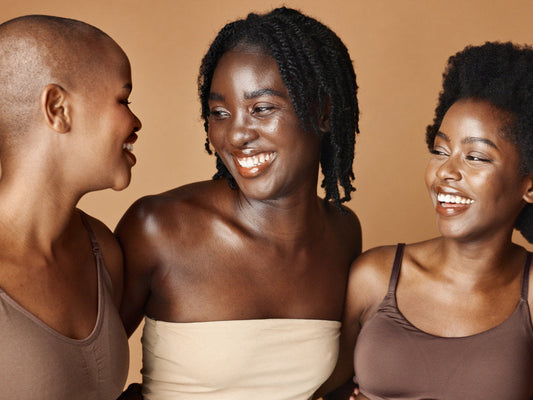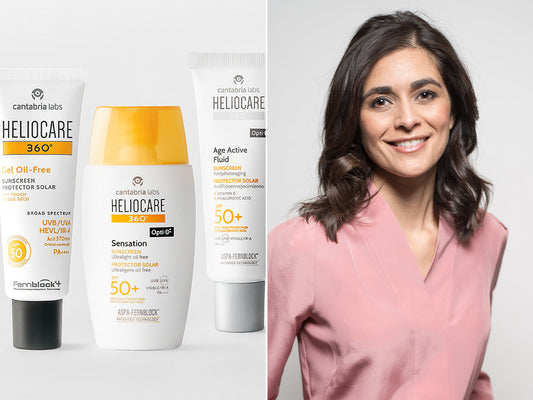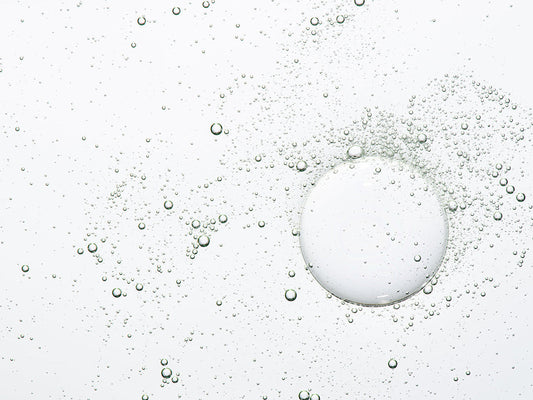What is photoageing and how can we prevent it?
Published on 24 October 2023
Photoageing occurs when the skin is damaged as a result of excessive sun exposure. It is also sometimes referred to as sun damage, solar damage, or photodamage.
What does photoageing look like?
Photoageing can present in a number of different ways. The inflammation caused by sun exposure causes a breakdown of the collagen and elastin that keeps skin firm. Sun exposure can also damage fibroblasts, the cells that produce collagen and elastin and maintain the skin’s structure. Sunburn and long-term sun exposure can also cause the epidermis, or top layer of the skin, to thicken. And it causes the skin to overproduce melanin, a natural pigment. The result of all this damage is:
- Sagging skin
- Loss of tone
- Fine lines
- Wrinkles
- Rough, uneven texture
- Dark patches
Forms of light and their effect on photoageing
There are four different types of solar radiation that contribute to photoaging: UVB, UVA, visible light and infrared-A. They can affect the skin in different ways and reach different layers of the skin as they do so.
UVB radiation is more intense in the summertime, but it only accounts for 5% of UV rays. It can cause more serious diseases of the skin, it does contribute towards photoageing, however it is mainly responsible for the temporary issues of sunburn and skin thickening as well as DNA damage which can lead to skin cancer and non-melanoma skin cancers such as actinic keratosis and basal cell carcinomas.
UVA is present all year round and makes up the other 95% of UV rays. Its long wavelengths penetrate deep into the skin, damaging collagen and elastin structures resulting in skin laxity, sagging skin and wrinkles. UVA rays are the cause of 85% of skin ageing and 46% of free radical production from solar radiation (vs. just 5% in UVB), which damages DNA and causes oxidative stress. UVA can also penetrate glass and cloud, making it important to protect your skin against UVA ray every single day, whatever the weather.
Visible light makes up approximately 40% of solar radiation reaching the earth's surface. Whilst the vast majority of visible light comes from the sun, blue light from our many digital devices is also a form of visible light that can contribute towards photoageing. 33% of free radical activity comes from visible light, and it contributes towards the development of hyperpigmentation and erythema (redness and inflammation). Studies have demonstrated that visible light contributes more to the development of dark spots and pigmentation than UVA – however the combination of the two results in more intense and persistent pigmentation of the skin.
Finally, infrared-A (IRA), which we feel as heat, makes up a third of all the solar radiation that reaches the skin. Over 65% of this type of light reaches past the epidermis (the top layer of skin) into the dermis, and it penetrates further into the skin than other forms of light, all the way to the hypodermis. Excessive or intense exposure to IRA raises the skin’s temperature and triggers inflammatory cells resulting in cellular oxidative stress triggering erythema, indirect DNA damage and damage to the skin’s structure.
What can we do to prevent photoageing?
Luckily, it isn’t difficult to protect your skin from premature ageing. There are easy precautions we all can take that will keep our skin healthy and looking its best for as long as possible.
Avoid direct sun exposure
If you want to avoid photoageing, your days on a lounger under the blazing sun are over. But keep in mind that UVA can reach your skin even through cloud, and glass, so you need to be aware of your environment and how the sun is reaching your skin. (For example, snow can reflect up to 80% of UV radiation, as anyone who’s gone skiing on a sunny day has probably experienced.)
Exercise caution
Avoiding the sun when it’s at its most intense, i.e. in the middle of the day, will reduce the amount of radiation you are exposed to. So will wearing protective clothing, such as broad-brimmed hats and long sleeves – it’s not only your face and neck that can show signs of photoageing!
Wear broad-spectrum sunscreen every day
Establishing a daily habit of applying sunscreen means you don’t have to remember to put it on and you’re always protected. Broad-spectrum, high SPF sunscreen (at least SPF30), which protects against UV radiation is good, but it's even better to use a full-spectrum protection sunscreen that also helps defend against visible light and infrared-A. High-quality sunscreens will often include additional ingredients such as antioxidants to improve the health and appearance of your skin.
When you put on your sunscreen, apply it correctly
Many people who apply sunscreen aren’t using enough to get the full SPF that their sunscreen contains. To cover your face and neck, you should be using roughly 2 finger lengths worth of sunscreen, and making sure that you apply it all the way up to your hairline and around your eyes (carefully). Apply it after moisturiser but before makeup. And once you’ve applied to your face and neck, consider what other areas need sunscreen as well – chest and hands are also important and tend to be forgotten.
Introducing Heliocare 360°
For full-spectrum protection and a wide variety of formulations designed for daily use, consider Heliocare 360° for your daily protection against photoageing. All Heliocare 360° daily sunscreens provide full-spectrum defence, with UVB (SPF50), UVA (PA++++), visible light and infrared-A protection, and contain intelligent ingredients to help boost skin health, including DNA repair enzymes and the supercharged antioxidant Fernblock®.
Heliocare 360° offers a wide range of daily sunscreens which offer targeted solutions for all skin types. With unique formulations designed to help prevent and reduce the symptoms of key skin concerns such as fine lines and wrinkles, pigmentation, and redness, as well as products that combine the benefits of full-spectrum daylight protection and foundation coverage, there’s a Heliocare 360° for everyone that you’ll love to use every day.
Discover your perfect Heliocare 360° daily sunscreen and make Heliocare part of your everyday today – Find out more.



